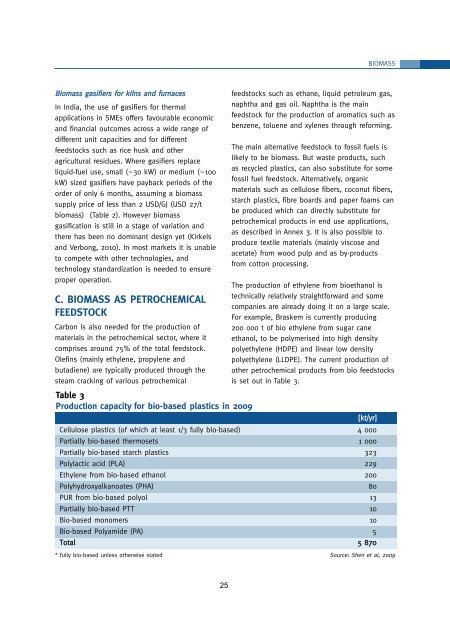Renewable Energy in Industrial Applications â an ... - Unido
Renewable Energy in Industrial Applications â an ... - Unido
Renewable Energy in Industrial Applications â an ... - Unido
Create successful ePaper yourself
Turn your PDF publications into a flip-book with our unique Google optimized e-Paper software.
BIOMASS<br />
Biomass gasifiers for kilns <strong>an</strong>d furnaces<br />
In India, the use of gasifiers for thermal<br />
applications <strong>in</strong> SMEs offers favourable economic<br />
<strong>an</strong>d f<strong>in</strong><strong>an</strong>cial outcomes across a wide r<strong>an</strong>ge of<br />
different unit capacities <strong>an</strong>d for different<br />
feedstocks such as rice husk <strong>an</strong>d other<br />
agricultural residues. Where gasifiers replace<br />
liquid-fuel use, small (~30 kW) or medium (~100<br />
kW) sized gasifiers have payback periods of the<br />
order of only 6 months, assum<strong>in</strong>g a biomass<br />
supply price of less th<strong>an</strong> 2 USD/GJ (USD 27/t<br />
biomass) (Table 2). However biomass<br />
gasification is still <strong>in</strong> a stage of variation <strong>an</strong>d<br />
there has been no dom<strong>in</strong><strong>an</strong>t design yet (Kirkels<br />
<strong>an</strong>d Verbong, 2010). In most markets it is unable<br />
to compete with other technologies, <strong>an</strong>d<br />
technology st<strong>an</strong>dardization is needed to ensure<br />
proper operation.<br />
C. BIOMASS AS PETROCHEMICAL<br />
FEEDSTOCK<br />
Carbon is also needed for the production of<br />
materials <strong>in</strong> the petrochemical sector, where it<br />
comprises around 75% of the total feedstock.<br />
Olef<strong>in</strong>s (ma<strong>in</strong>ly ethylene, propylene <strong>an</strong>d<br />
butadiene) are typically produced through the<br />
steam crack<strong>in</strong>g of various petrochemical<br />
Table 3<br />
Production capacity for bio-based plastics <strong>in</strong> 2009<br />
feedstocks such as eth<strong>an</strong>e, liquid petroleum gas,<br />
naphtha <strong>an</strong>d gas oil. Naphtha is the ma<strong>in</strong><br />
feedstock for the production of aromatics such as<br />
benzene, toluene <strong>an</strong>d xylenes through reform<strong>in</strong>g.<br />
The ma<strong>in</strong> alternative feedstock to fossil fuels is<br />
likely to be biomass. But waste products, such<br />
as recycled plastics, c<strong>an</strong> also substitute for some<br />
fossil fuel feedstock. Alternatively, org<strong>an</strong>ic<br />
materials such as cellulose fibers, coconut fibers,<br />
starch plastics, fibre boards <strong>an</strong>d paper foams c<strong>an</strong><br />
be produced which c<strong>an</strong> directly substitute for<br />
petrochemical products <strong>in</strong> end use applications,<br />
as described <strong>in</strong> Annex 3. It is also possible to<br />
produce textile materials (ma<strong>in</strong>ly viscose <strong>an</strong>d<br />
acetate) from wood pulp <strong>an</strong>d as by-products<br />
from cotton process<strong>in</strong>g.<br />
The production of ethylene from bioeth<strong>an</strong>ol is<br />
technically relatively straightforward <strong>an</strong>d some<br />
comp<strong>an</strong>ies are already do<strong>in</strong>g it on a large scale.<br />
For example, Braskem is currently produc<strong>in</strong>g<br />
200 000 t of bio ethylene from sugar c<strong>an</strong>e<br />
eth<strong>an</strong>ol, to be polymerised <strong>in</strong>to high density<br />
polyethylene (HDPE) <strong>an</strong>d l<strong>in</strong>ear low density<br />
polyethylene (LLDPE). The current production of<br />
other petrochemical products from bio feedstocks<br />
is set out <strong>in</strong> Table 3.<br />
[kt/yr]<br />
Cellulose plastics (of which at least 1/3 fully bio-based) 4 000<br />
Partially bio-based thermosets 1 000<br />
Partially bio-based starch plastics 323<br />
Polylactic acid (PLA) 229<br />
Ethylene from bio-based eth<strong>an</strong>ol 200<br />
Polyhydroxyalk<strong>an</strong>oates (PHA) 80<br />
PUR from bio-based polyol 13<br />
Partially bio-based PTT 10<br />
Bio-based monomers 10<br />
Bio-based Polyamide (PA) 5<br />
Total 5 870<br />
* fully bio-based unless otherwise stated Source: Shen et al, 2009<br />
25

















